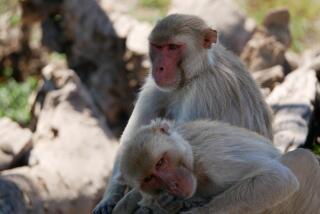SCIENCE / GENETICS AND HOMOSEXUALITY : Survey of Identical Twins Links Biological Factors With Being Gay
- Share via
The second study in several months to strongly suggest a genetic component to homosexuality has been reported by researchers at Northwestern University and Boston University.
The study found that more than half of the 56 identical twins of homosexual males studied were also gay, researchers report today in the Archives of General Psychiatry. In contrast, only 22% of the non-twin brothers of the homosexuals were found to be gay, and only 11% of adoptive brothers were gay. This provides new evidence that genetics play a more important role than environment in the development of homosexuality, said psychologist J. Michael Bailey of Northwestern and psychiatrist Richard C. Pillard of the Boston University School of Medicine.
But the fact that not all of the identical twins are gay, they caution, indicates that other factors, such as exposure to hormones or trauma in the womb or some unknown factor in the everyday environment, are necessary for a genetic predisposition to homosexuality to be manifested.
The research comes on the heels of a Salk Institute study suggesting that a specific area of the brain is smaller in homosexual males than in other males. That portion, called the INAH-3, controls sexual behavior.
The two studies are highly complementary, said molecular biologist Dean Heimer of the National Institutes of Health.
“The simplest interpretation would be that there is a gene, or genes, that control the growth of (INAH-3),” he said. “Both point to the same idea, that there is a biological component of sexual orientation.”
In fact, that discovery is not too surprising to scientists. “If you think about it, there must be a strong genetic component to heterosexual orientation, or the species would not have survived so long,” Heimer said. “So it is only natural that there is a genetic component to homosexuality as well.”
Ellen Carton, chairwoman of the Gay and Lesbian Alliance Against Defamation, said the new study “gives credence to what we in the gay and lesbian community have been saying all along, that sexual orientation is deeply ingrained and not something that we casually choose.”
What is surprising to some is that it has taken scientists so long to look carefully at the biological aspects of sexual orientation.
“Part of the reason is that, until recently, homosexuals have been too closeted to participate freely in research. That’s much less of a problem now,” Bailey said.
Furthermore, Heimer said, “There is still a substantial taboo in the scientific community about studying any aspect of sex. It’s considered a personal, private sort of matter. That taboo gets even stronger with homosexuality.”
“To be honest,” Bailey said, “there is an element of homophobia (in the scientific community) and heterosexuals are hesitant to get involved in this kind of research because they fear the inference will be made they are gay. That’s why it has been less well researched than it should be.”
Pillard had reported in a 1986 study that homosexuality runs in families, a fact that seemed apparent to many observers but had not previously been scientifically demonstrated. He and Bailey teamed up to try to determine whether that tendency was caused by genetics or environment, the well-known “nature vs. nurture” debate.
They advertised in gay publications to locate male homosexuals, especially twins, who had at least one male sibling, no matter what the latter’s sexual orientation. They carefully evaluated that orientation, primarily through personal interviews. (They are currently conducting a similar study of lesbians and expect to publish results soon.)
They identified 56 pairs of identical twin brothers in which at least one of the pair was gay. Identical twins have identical genetic makeups and, if homosexuality has a genetic basis, many of the second twins should also be gay. That is what they found: 52% of the identical twin brothers were gay.
Bailey and Pillard also found 54 pairs of fraternal twin brothers, who share some of their genes, but not all. Among this group, 22% of the brothers were also gay.
Finally, they studied 57 adoptive brothers who were raised in the same households with 46 gay men, but who shared no genes. Only 11% of this group was gay. The incidence of homosexuality in the population at large is estimated at 4% to 11%.
Because all the pairs of brothers studied were raised in the same households, environmental differences among the three groups were largely eliminated, Bailey said. As a result, “The research strongly suggests a genetic contribution to sexual orientation,” he said.
Nonetheless, the fact that 48% of the identical twins were not gay suggests that environment also plays a role. Furthermore, he added, the twins provide an ideal laboratory in which to try to isolate and identify those environmental influences--a project he is working on.






